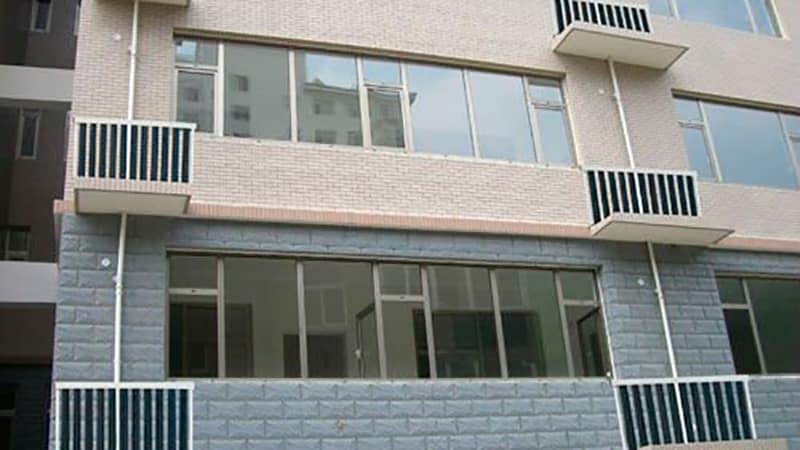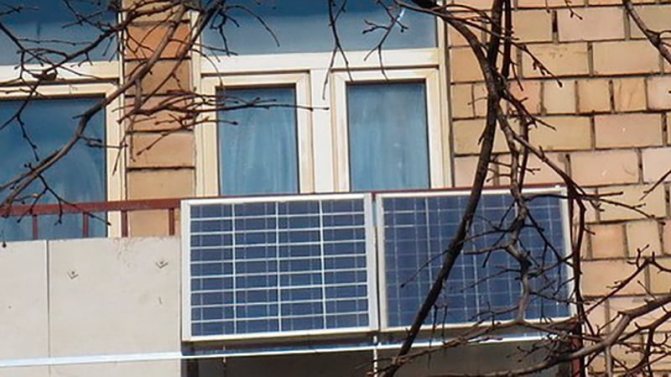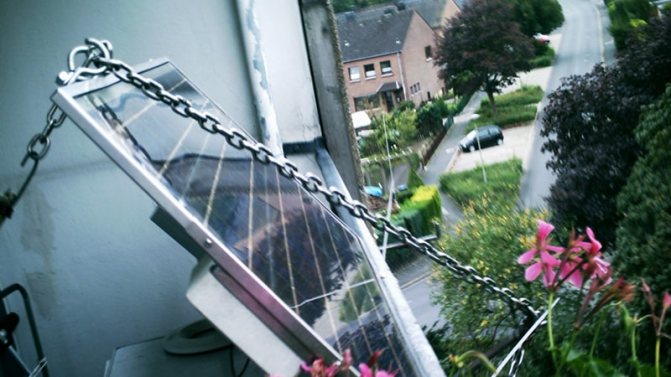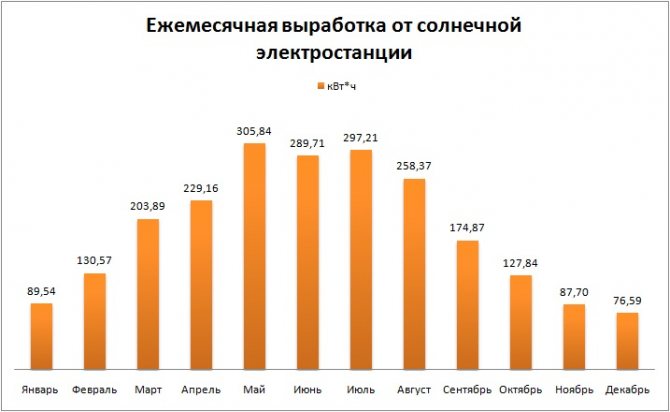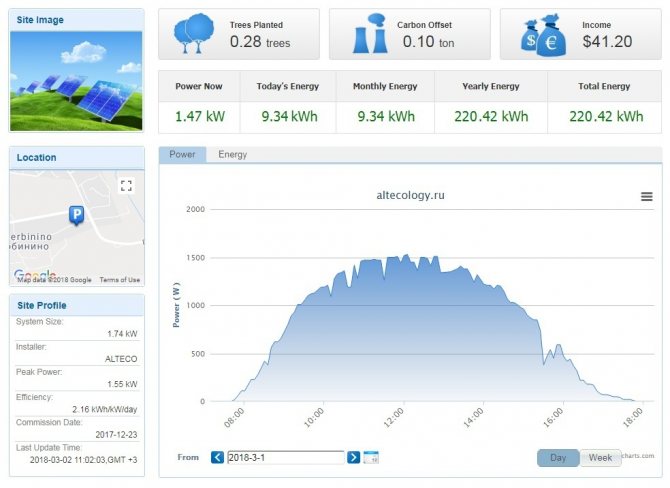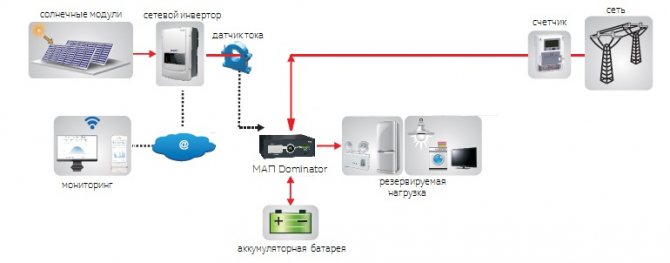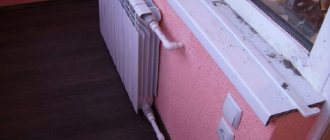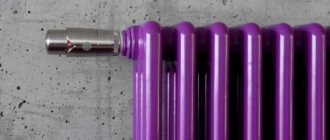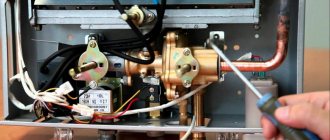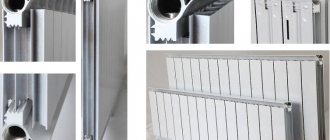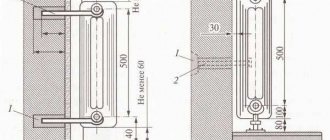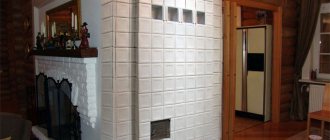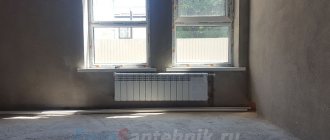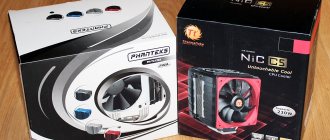Place of installation
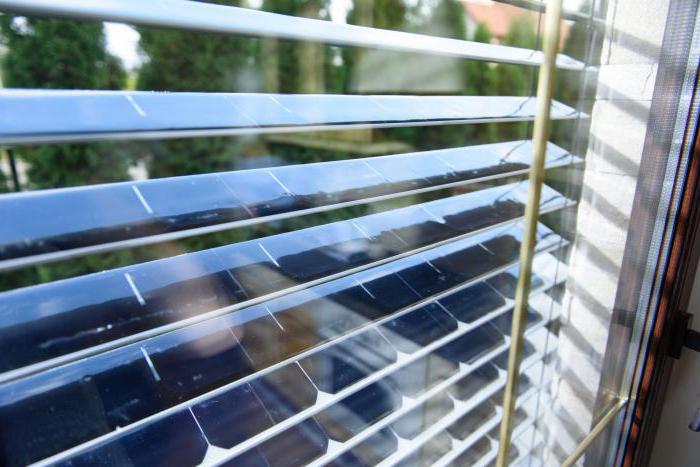
In order for solar panels to work with the greatest efficiency, it is necessary to take into account the peculiarities of their location. For example, if the battery is in a shaded area, it will not be able to generate enough power for normal operation. As a result of improper installation, the structure may fail after a while, not having time to justify the purchase costs.
Solar panels for an apartment should be directed towards the sun. It is important to carry out the installation so that the flow of sunlight falls on the solar cells of the battery most of the day. If the house is located in the northern hemisphere, then the front of the device should be oriented to the south. When in the southern hemisphere, you must install the batteries so that they face north. The slope is also quite an important aspect and depends on the geographic location. As experts advise, the angle of inclination should be equal to the latitude in which it is located.
Solar panel on the balcony, experience of use
Hi Geektimes. This article is a continuation of the previous part, about the tourist charger "Anker Solar 21W". The idea of using a solar battery to charge various gadgets seemed to me very promising, but of course, 21W as a universal charging is not enough - I want to be able to charge not only in sunny weather, but for this you need a power reserve. Therefore, full-fledged solar panels were purchased and experiments with them began.
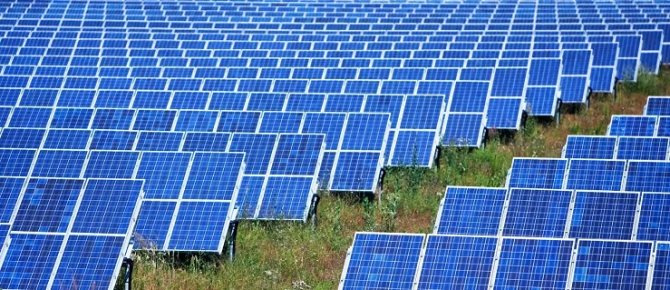

What came of it, details under the cut.
Iron
1. Solar panel
There are different options, but the main limitation on the balcony is the availability of free space. To understand the order of prices, a 50W battery costs about 5000 rubles and looks like this:
Panel dimensions in mm - 540x620x30, weight 4kg.
Balconies are different in size, based on the dimensions of the panels, it is quite possible to place 2 or 4 pieces without any problems, it will no longer fit. For the test, 2 panels of 50W each were bought. Such a battery gives about 18V under load or 24V without it, which means that when using 2x batteries, you need to count on a total voltage of up to 50V (for example, many dc-dc converters normally operate up to 30V). It is possible to connect the batteries in parallel, but then the losses due to the length of the wires will be slightly higher.
2. Controller
There are 2 options here:
- Solar panels + controller + battery
This is a classic design: the controller charges the battery when there is sun, the user uses this energy when he needs it.
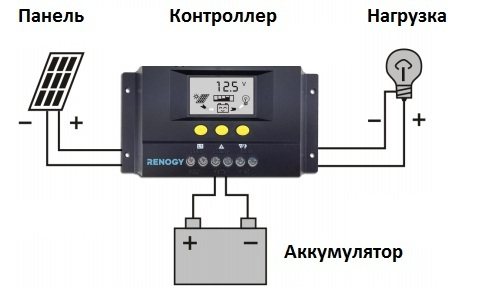

This system has several advantages:
- energy can be used whenever, and not only when it is light, - the ability to connect an inverter and receive 220V at the output, - as a bonus, a backup source in the house in case of a power outage.
There is only one drawback: the use of a large-capacity battery fundamentally kills the environmental friendliness of the idea of this event. The number of charge / discharge cycles of batteries is limited, they do not like overdischarge, and besides, batteries and controllers are quite expensive. The price of the controller ranges from 1000r for the cheapest PWM version, up to 10000-20000r for the more expensive (and efficient) version with MPPT support (you can read what MPPT is here). The price of the battery is from 5000r for a regular gel battery for 40-50A * h, some use LiFePo4 batteries, of course they are more expensive.
- Grid-tie inverter
This technology is the most promising at the moment.
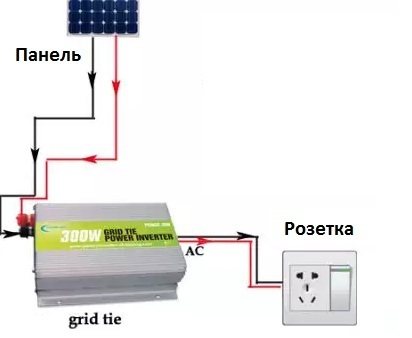

The bottom line is that the converter converts and delivers energy directly to the home power grid.At the same time, the energy consumed from the general network decreases, the house electric meter records lower readings.
Ideally, if solar panels provide enough energy for all consumers, the value on the electricity meter will not increase at all. And if the consumption of an apartment / house is less than the production of solar panels, then the meter will record the "export" of energy, which must be taken into account by the electricity supplier. In Russia, however, such a scheme does not work yet - moreover, most of the old electricity meters consider energy "modulo", i.e. you will also have to pay for the energy supplied. It seems that in 2020, they promised to start solving the issues of microgeneration at the legal level. But however, for the panels on the balcony, all this is only of theoretical interest - their production is too small.
The price of a grid-tie inverter starts from $ 100, depending on the capacity. Separately, it is worth noting micro-illuminators - they are placed directly on the battery, and immediately give off the mains voltage, however, the recommended panel power is at least 200W. The inverter is mounted directly on the back of the solar panel, which allows them to be connected as follows:
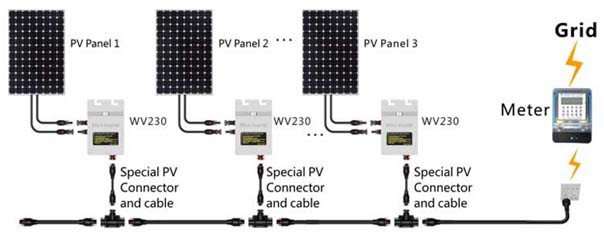

But for the balcony, of course, this is irrelevant.
Testing
The first step was to find out what real power can be obtained from solar panels. For this, an ADS1115 ADC board for the Raspberry Pi was purchased for $ 15:
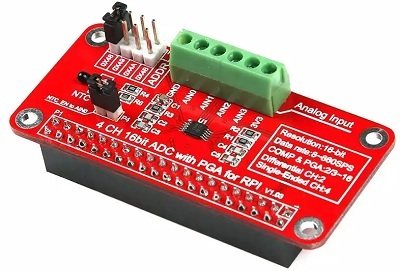

It is easy to use, the input voltage is divided by a divider and fed to the analog input, at the output we have digital values. The sources for working with the ADC can be taken here. An ACS712 current sensor was also purchased, the voltage sensor was made from a bunch of resistors (only one nominal value was found at home). An ordinary 100W light bulb was installed as a load. Of course, it did not burn from 48 volts (the light bulb is designed for 220V), but only barely glowed. The resistance of the spiral is 42 Ohm, which allows you to roughly estimate the power by voltage (although the resistance of an incandescent lamp is nonlinear, but for a rough estimate it will do).
The first test version looked like this:
Techno-fetishists don't look!
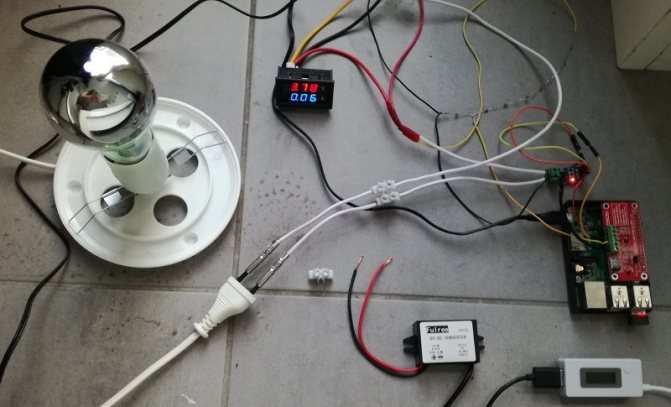

The source was added so that the data and the current time were saved in CSV, and a web server was launched on the Raspberry Pi to download files over the local network.
The results for an ordinary, quite clear day with variable cloud cover look like this:
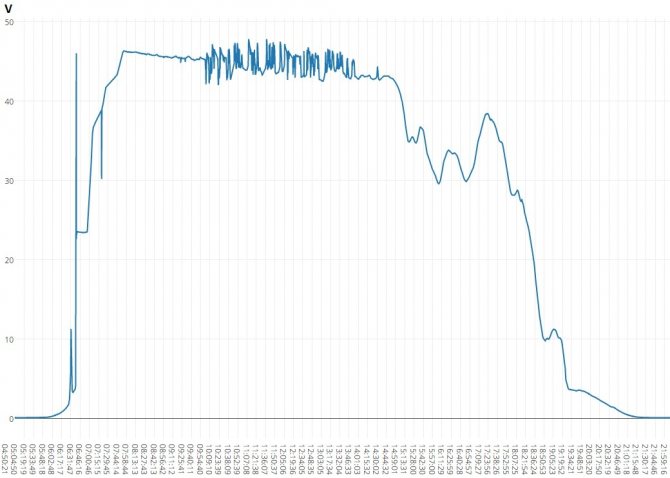

It can be seen that the voltage peak occurs in the early morning, which is a consequence of incorrect installation of the panels - ideally, they should not stand vertically.
And this is what the "failure" looks like on the day when the clouds came and it started to rain:
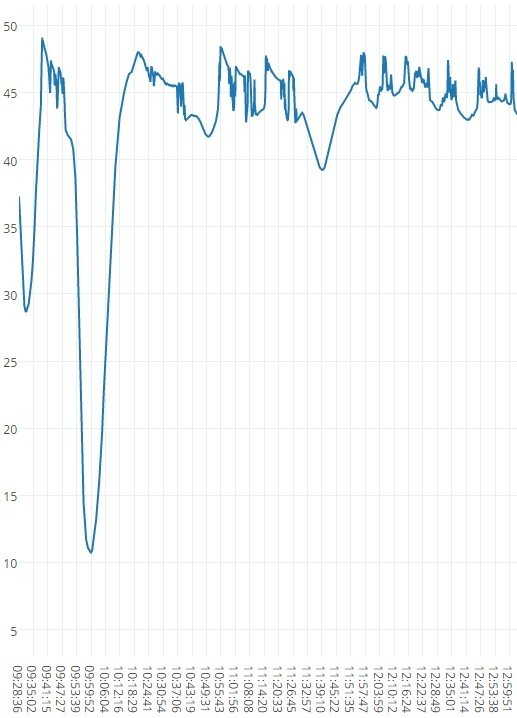

Given the voltage of 44V and the resistance of the lamp filament of 42Ohm, we can roughly estimate (we ignore the nonlinearity of the lamp resistance) that, at best, the resulting power is P = U * U / R = 46W. Alas, the efficiency of a 100-watt panel when installed vertically is not very good - the sun's rays do not fall on the panel at a right angle. In the worst case (cloudy, rain), the power drops even to 10W. In winter and summer, the total energy received will also differ.
The experiment with the return of energy directly to the network turned out to be unsuccessful: a 500-watt inverter from 45 watts simply did not work. In principle, this was expected, so the inverter was left for the future before moving to a place with a larger balcony.
As a result, given the decision to abandon buffer batteries, the only working option was to use dc-dc converters directly: for example, such a converter can charge any USB devices, its output already has a USB connector:
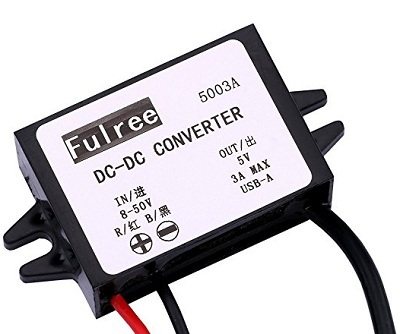

There are models that are slightly more expensive, they have a higher maximum current and a larger number of USB connectors:
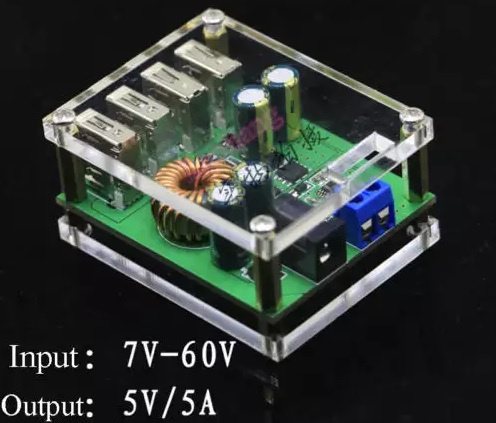

There is also an idea to find a dc-dc converter for charging a laptop, there are a lot of them on eBay.
Conclusion
This system is experimental in nature, but in general it can be said that it works.As you can see from the graph, from about 7 am to 5 pm, the power delivered by the panels is more than 30W, which, in principle, is not so bad. In very cloudy weather, the results are obviously worse.
Of course, there is no question of economic feasibility - when generating 40W * h for 7 hours, 2 kW * h will be generated in a week. Everyone can estimate the payback in prices of their region on their own. The question, of course, is not about the price, but about gaining experience, which is always interesting.
But what to do with the energy, the question is still open. Using 40W to charge USB devices is overkill. On eBay there are 300W grid tie inverters with an operating voltage of 10.5-28V, but there are few reviews on them, and I don't want to spend $ 100 on a test. If a suitable solution is still not found, we can assume that one 50-watt panel is the optimum for a balcony - it can be used to charge different gadgets, redundancy in this case is minimal.
At least now all home digital devices (phones, tablets) are switched to green energy without much hassle. There is still an idea to consider using a buffer LiFePo4 battery - but the question of choosing both the battery and the controller is still open.
In addition: as suggested in the comments, you can use a lead-acid battery, such as a car battery. Yes, this is a really cheap and working option, with a 100-watt panel, something like this controller will be enough for only $ 10-20 on eBay:
Photo
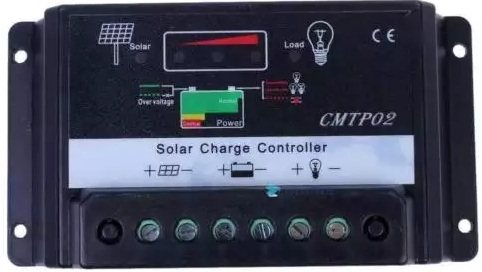

Google for PWM Solar Charger. But this solution is not entirely environmentally friendly and not entirely interesting, so I do not consider it in terms of studying technologies. And if someone needs, for example, to power a video camera in the country, then probably it is quite an option.
Continued in the next part. A short video version can also be viewed in the video on youtube.
PS: In the comments they asked to post a photo, at the moment the batteries look like this:
Photo
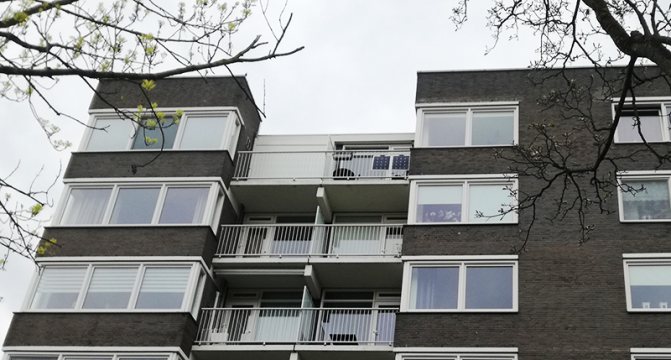

This size of the panels does not interfere with the use of the balcony and, in principle, does not spoil the appearance. Also, as suggested in the comments, it is more profitable to buy panels of higher power, the optimum for the price is panels for 150-200W, but their placement is a little more complicated, and it is already necessary to figure out the dimensions, whether the panel will fit or not. The question of reliable fasteners also arises.
Additional recommendations for choosing a location
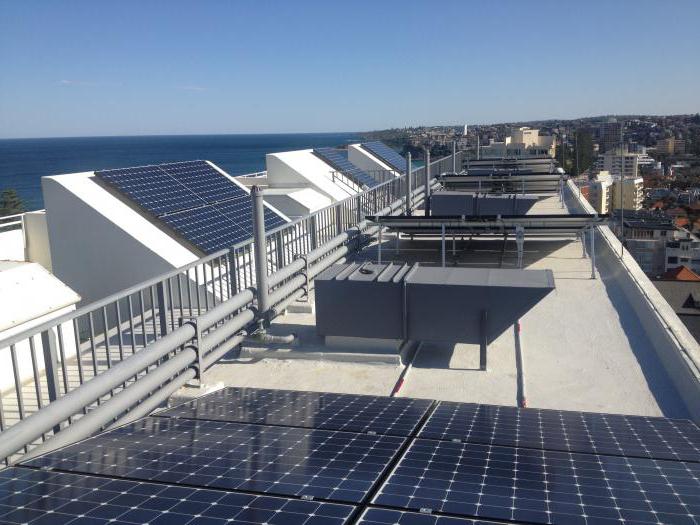

If the house is not at the equator, then the angle correction must be carried out depending on the season. It is important to provide access to the batteries. The invention is unpretentious, but its front surface can eventually become covered with dirt and dust; in winter, the battery can be covered with snow. If this happens, then the accumulation of energy will decrease. In order to solve the problem, the base of the structure must be regularly cleaned. It is important to remember that a layer of snow on the surface of the battery can cause interruption in energy production, therefore it is necessary to monitor the condition of this part of the panels.
Myth 4: "Snow will be the main enemy"
In their reviews, Internet users often point to the threat of snow, indeed, it can block access to light, but only if frost appears, and the snow has something to catch on.
On top of that, this problem is quickly resolved by the wind. Also, a good solution would be to install batteries not on the roof, but not on the walls of the house, since in winter the sun gives "grazing" light, and the vertical position of the batteries will only improve their performance.
In winter, no less rays fall on the silicon wafers. Therefore, we can safely say that the problem of snow is a contrived lack of solar panels.
Installation steps
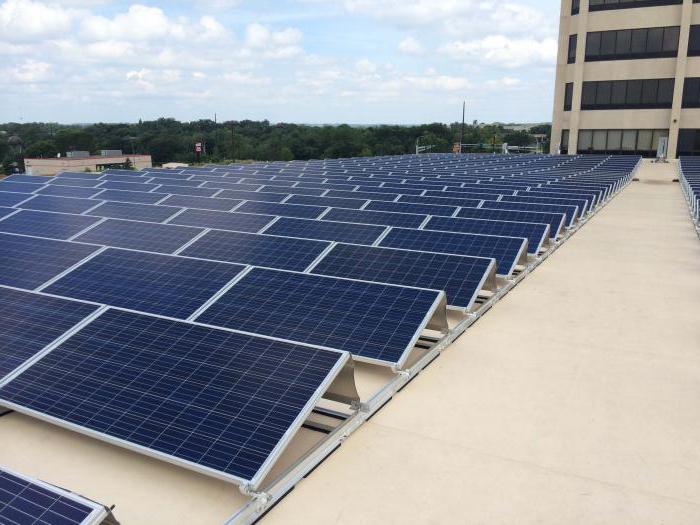

You can install solar panels for an apartment yourself. It is important to decide where they will be located; special farms or the roof of a house can become a place. If you stop at the last option, you will have to install the profiles and fix the panels on the bolts.It is recommended to use fasteners for this, the diameter of which varies from 6 to 8 mm.
If solar panels for an apartment are installed on profiles, this will allow them to be fixed in a stationary state and save space on the balcony. When installation is carried out on land farms, you should first purchase them. They are usually aluminum profiles, corners or iron elements, supplied in a collapsible form.
Installation of solar panels
Installation of the system requires special skills. Self-installation is not recommended, because with the slightest mistake in the calculations, you risk de-energizing the house. If unsuccessful, the cost of repairs may exceed the price for installation services.
Most often, the installation price is calculated from the cost of the system in the amount of 10-15%. You should not be intimidated by high prices. companies that install this equipment, for this amount, provide a guarantee (that everything will be connected and installed correctly) for at least 1 year.
By ordering a professional installation, you will get rid of problems. Experts will calculate the required number of panels, help you determine the type of batteries, correctly determine the optimal installation location, angle of inclination and other parameters.
Installation of a standard installation up to 5 kW is carried out within one day.
Methods of work
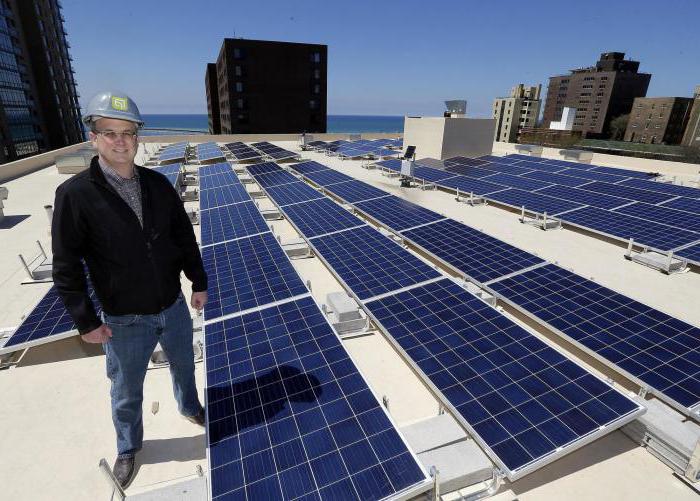

To carry out the work, in addition to the fasteners, you will need keys, the size of which depends on the parameters of the bolts. In order to install solar panels in an apartment, you need to assemble a farm, and then choose a place, guided by the advice given above. The installation site can be the roof. The structure is fixed on it in the designated place, and then the panels are installed.
In the final step, it is important to make sure that the batteries do not move, even in strong gusts of wind. Once the above steps have been completed, you can proceed to connecting the batteries to the panels. The first of them will be connected to controllers or inverters.
Solar panels: to install or not
Of course, an autonomous solar power plant on polycrystalline or monocrystalline batteries is indispensable in places where there is no electricity at all. But where there is electricity, it makes sense to connect a grid station without a battery, which will compensate for the costs during the day, and the excess energy can be sold to the city grid at a special "green" tariff.
An example of using solar panels in a country house: all week from Monday to Friday, solar panels give excess electricity to the city grid (and you get paid for this), and on weekends you come to the country house and relax for free.
The 220-on company offers the optimal, proven equipment for the current tasks of the client without any markups or overpayments. The catalog contains models from reliable and proven manufacturers. All models provide high performance and power.
220-on specialists will perform installation and carry out warranty and post-warranty service. You can get advice on the selection of equipment by phone or by calling the toll-free hotline 8-800-500-20-74.
Installation features
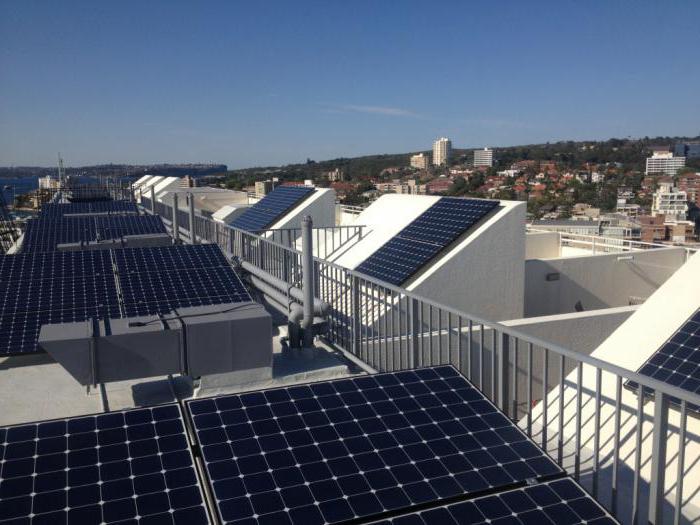

If you decide to install solar panels for an apartment in an apartment building, you should study the nuances of installation. Whichever type of installation you choose, you need to monitor the angle of inclination. It is important to take into account that batteries, if installed incorrectly, may be shadowed by each other. If you install the elements on the same plane, then with the help of trusses you can form several levels. It is important to consider the distance to avoid shading.
In order to use the available space more efficiently, battery placement techniques should be combined.For example, roof-mounted batteries can be supplemented with ground-based systems. It is important to remember that after installing solar panels, it will not be possible to refuse the services of local power grids, because houses have energy-intensive devices such as TVs, irons, electric heaters, for the operation of which the charge of the modules will not be enough. Therefore, before installing solar panels in an apartment, you need to think about whether the event will be cost-effective. After all calculations have been made, it is necessary to purchase the main parts of the system, namely:
- solar panels;
- accumulators;
- inverters;
- controller.
How to choose the right autonomous system
Before buying a solar power plant, consider the following parameters:
- Daily consumption of connected electrical appliances.
- Place of installation of solar panels (orientation to the south, optimal angle of inclination, no shade on the panels).
- Place of installation of the battery (should be in a room with a positive temperature, but not higher than 25 degrees).
- Peak loads of electrical appliances (pumps, refrigerator).
- Year-round or summer-only operation of the system.
Monocrystalline is more often used in regions with high solar activity, polycrystalline - with low solar activity. If you need a solar battery for a summer residence, pay attention to micromorphic models. They are inexpensive, but have 2 times the area. Micromorphic silicon systems can work effectively at wide angle and in cloudy weather. For large stations that are installed on the roofs of enterprises and on the ground, it is better to use heterostructural modules (efficiency 22%) Russian (Hevel).
Specialist advice
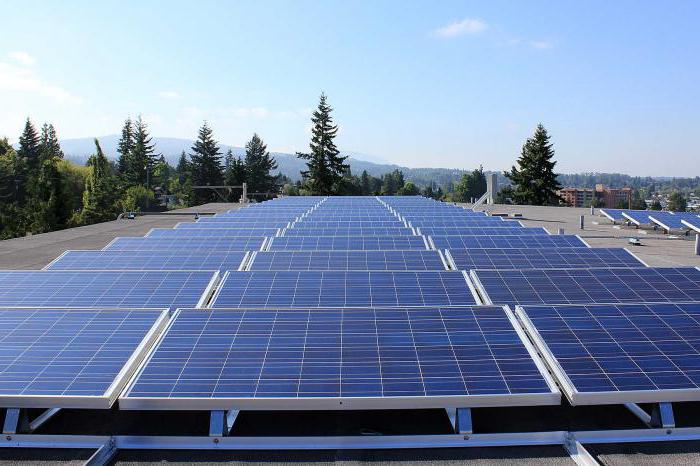

As practice shows, the main problem when installing batteries and accumulators is choosing the right place. Solar panels should be exposed to sunlight for most of the day, there are very few such places in an apartment, so there is not much choice. To do this, you can use the walls closest to the balcony and balcony glazing. This is true if roof mounting is not possible.
Most often in recent years, batteries are installed on the balcony glass, but this negatively affects the natural light in the apartment. Some consumers find positive aspects in such a way out, which are associated with a delay in ultraviolet radiation. Fastening in this case can be carried out in a balcony frame or on glass.
A set of solar panels for an apartment can be installed using this technology only if the balcony is on the sunny side, otherwise the installation does not make sense. The next important point will be to find a place for the location of the accumulating elements. When purchasing an average set for an apartment, you should get batteries in the amount of 20 to 30 pieces. For an apartment in a panel building, this area is quite large. It will be difficult to place so many batteries.
You can solve the issue by placing the elements in the upper part of the balcony ceiling. However, this place is rarely used. For this, a shelf is usually built on which all the batteries are located, which in this case will not be visible, in addition, they will not interfere. It is important to remember about the weight of the elements, the weight of each can vary from 15 to 20 kg, so the shelf must be reliable.
General characteristics and the ability to buy solar panels for a private house
If we talk about solar panels in technical terms, you need to understand that we are talking about photovoltaic power supply systems (PSE). The main purpose of such devices is to convert sunlight into electrical energy based on the physical law of the photoelectric effect. The process of improving solar power generation plants has been going on for about two hundred years.Currently, engineering thought has achieved significant results in the development of photovoltaic equipment, especially in terms of efficiency - from 1 to 46% (the share of converted solar energy).
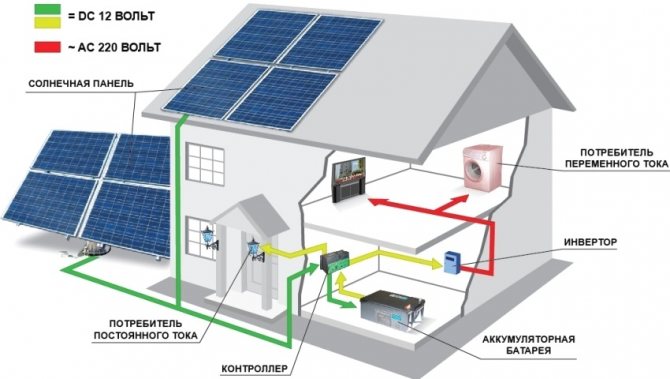

Solar panels convert energy from sunlight into electrical energy
The modern market for solar power supply systems can be considered sufficiently formed, since it allows you to make a choice of goods from a considerable number of offers, from a very large market segment. To answer the most frequently asked question, how much are solar panels for a private house, it is necessary to understand the technological and design features of the FSE. The structuring of the equipment offered by the market involves three main categories of solar systems, based on their functional, design and technical features.
The first category of FSE includes autonomous systems that are not connected to the main power supply network. Such systems operate on their own network loop for direct power supply of connected equipment. Maximum operating efficiency is achieved by the presence in the set of a storage device (batteries), which allows the use of the accumulated electricity in the event of a drop in the intensity of sunlight (i.e., reduced generated power) and in the case of moments when the power consumption exceeds the generated power.
Also, an installed set of solar panels for a home, used directly by load sources without battery cells, can be considered autonomous.
The second category includes open FSEs. In their configuration, these systems do not have batteries and are connected to the main power supply network through a special inverter. If the consumed power does not exceed the value generated, the main network is disconnected. Otherwise, the FSE is turned off and consumption is made from the main network. Such systems are very reliable, cheaper, but if there is no power supply from the main network, then the solar station does not work either.
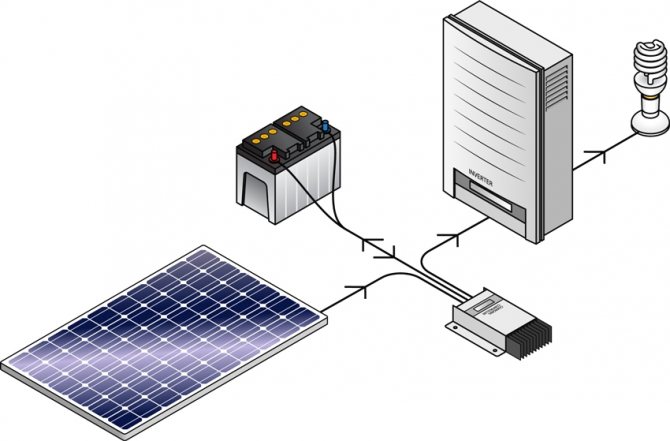

Autonomous FSE system with battery and photovoltaic inverter
The third category is represented by combined PSEs. They are a combined format of the first and second category. This allows you to have additional quality in your functionality - excess generated or accumulated electricity can be transmitted to the main network and have commercial value.
This category is the most expensive, as it uses complex grid-connected photovoltaic inverters and chargers in its configuration.
Helpful advice! For uninterrupted power supply in cases of simultaneous interruption of the general network and the impact of negative weather conditions, it is necessary to have a backup power supply. As such a source can be a small (2-5 kW) electric generator running on gasoline or diesel fuel.
Solar panels price for home: kit cost
It is necessary to resolve the issues of saving energy costs due to the installation of solar power plants in conditions of full information about the prices for the entire set and the forthcoming costs of their installation and operation. The frequent question, how much does a solar battery for a home cost, does not have a clear answer, since a lot of factors affect pricing.
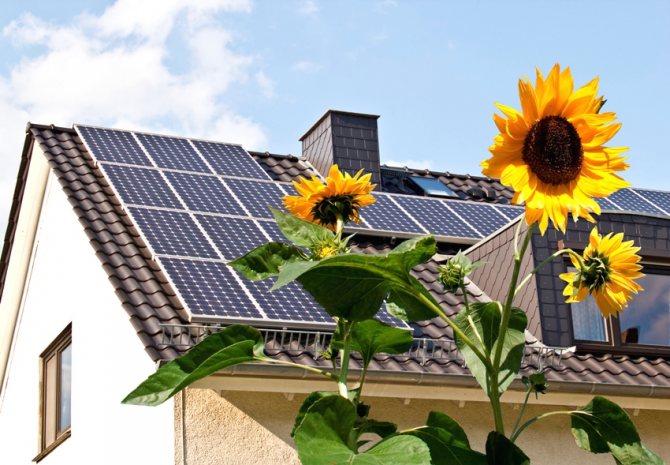

The cost of a minimum set of solar panels for a home is 120,000 rubles
The established price of the main element of the PSE (solar battery) is on average at a minimum (but also at a minimum in quality) of the order of 50-60 rubles. for the generated 1W of power. Consequently, the price of solar panels for a private house with a capacity of 100 and 200 W will be in the amount of 6,000 and 12,000 rubles. respectively.
The composition of the station set depends on its category and capacity.It may include a charging controller, battery station, inverter and interconnection equipment. When choosing, for example, a set of the first category and a rated power of about 2 kW (2000 W), the price of a set of solar panels for a home will be from 120 thousand rubles. and higher.
And it is necessary to compare the entire spent capital with the economic effect obtained from the difference in the cost of 1 kWh of the centralized network and the cost created by the FSE.
The most recent statistics of the solar panels market show that the ratio of prices per unit of electricity is 8.8 times. This means that the electricity generated by the solar station is 8.8 times cheaper than the electricity provided through the general grid, taken in equal equivalent.
An important criterion for choosing in the direction of using the FSE is also the factor of the ability to ensure the uninterrupted operation of automation in heating systems, security monitoring and fire warning systems. The list includes a computer home network and a group of electronic control and measuring sensors.
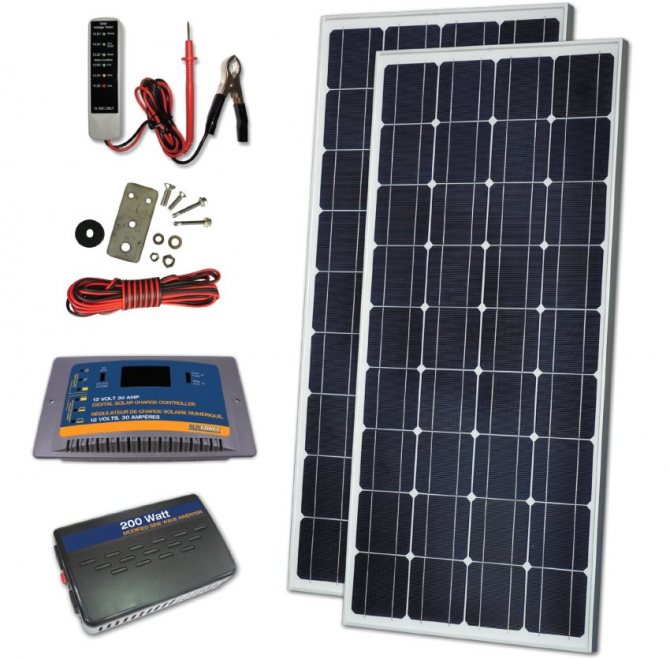

The kit may include, in addition to solar panels, a charging controller, a battery station, an inverter, and connecting equipment.
Application and price of solar panels for home
A large selection of solar panels makes it possible to use them in a variety of qualities and applications, since if you want to buy solar panels for your home, the price today already allows you to do this for a wide segment of the population. Knowing their main characteristics, such as the output voltage standard (12, 24V and higher), as well as the parameters of the generated rated power, you can use them locally without purchasing the entire set. On the market, the average cost of solar panels for a private house ranges from 60 rubles. for the generated 1 kW of electrical power.
If you need to use a light bulb in a dark room with a voltage of 12V and a power of 25 W, then it is enough to buy and connect directly to it a solar battery of similar parameters and it will cost no more than 2,000 rubles. and you won't have to spend electricity on a 60-75 W light bulb in some closet. You can connect a small well pump for daily irrigation of any landscape area with a power of 200 W and a power supply of 24 V. At a cost of 11,000-12,000 rubles. it is possible to have an independent irrigation system during the entire spring-summer period and for more than 10 years.
Necessary set of solar panels for summer cottages
If we consider the question of the expediency of using solar systems for a summer cottage, one should take into account the factors of stability in the supply of electricity to the village, the level of its insolation (the time spent in direct sunlight), the required electrification power and the risk factor of theft during the time of the year that is empty from the owners. The best option is the first category stationary PSE installation.
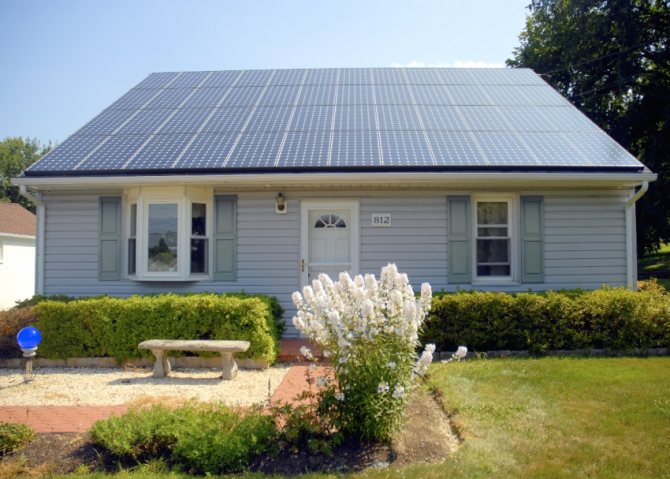

The best option for a summer residence is a stationary installation of the first category FSE
Given the low power consumption of the dacha, it is possible to organize 100% replacement of centralized power supply with an autonomous and cheap one. In another case, when a stationary installation of a solar station is not justified by some criteria, you can use a quick-assembly moving kit.
Note! Experts in the field of the use of PSE calculated and found that solar panels are strategically and economically feasible for use in the summer season in private houses and country houses with an area of 50 to 300 m², designed for a family of up to four people.
What is important to remember
It is necessary to pay special attention to the insulation of the shelf. This is due to the fact that in cold weather, the capacity of the batteries can be reduced if they are not protected from frost. In order for the batteries not to work in vain, they need to be insulated with high quality.If the installation of alternative sources is carried out incorrectly, then you will only face unnecessary costs. Therefore, you should reconsider your opinion regarding some electrical appliances.
Before installing batteries, experts recommend abandoning powerful consumers, replacing them with less energy-intensive ones. For example, a laptop or computer will perfectly replace plasma panels. They are not so energy intensive and allow you to save kilowatts. A prerequisite will be the use of energy-saving bulbs, but LED lighting devices are the ideal option.

